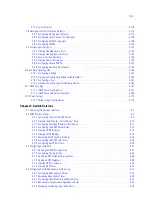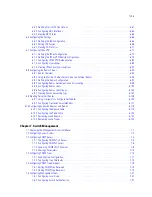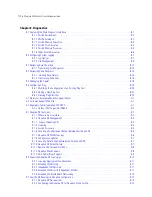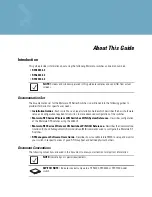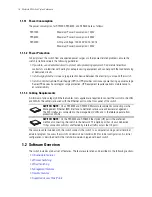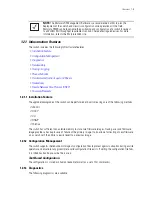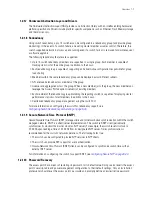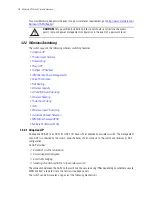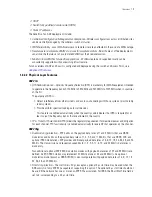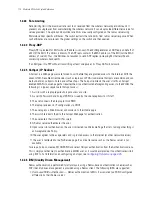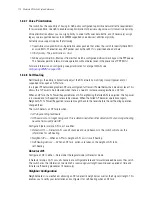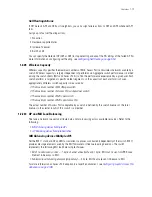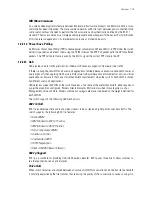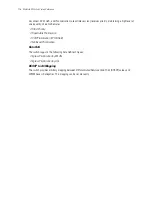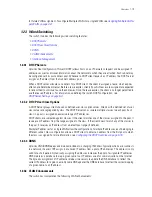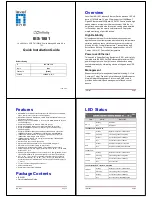
Overview
1-7
1.2.1.7 Hardware Abstraction Layer and Drivers
The
Hardware Abstraction Layer
(
HAL)
provides an abstraction library with an interface hiding hardware/
platform specific data. Drivers include platform specific components such as Ethernet, Flash Memory storage
and thermal sensors.
1.2.1.8 Redundancy
Using switch redundancy, up to 12 switches can be configured in a redundancy group (and provide group
monitoring). In the event of a switch failure, an existing cluster member assumes control. Therefore, the
switch supported network is always up and running even if a switch fails or is removed for maintenance or
a software upgrade.
The following redundancy features are supported:
• Up to 12 switch redundancy members are supported in a single group. Each member is capable of
tracking statistics for the entire group in addition to their own.
• Each redundancy group is capable of supporting an Active/Active configuration responsible for group
load sharing.
• Members within the same redundancy group can be deployed across different subnets.
• APs are load balanced across members of the group.
• Licenses are aggregated across the group. When a new member joins the group, the new member can
leverage the Access Port adoption license(s) of existing members.
• Each member of the redundancy group (including the reporting switch) is capable of displaying cluster
performance statistics for all members in addition to their own.
• Centralized redundancy group management using the switch CLI.
For more information on configuring the switch for redundancy support, see
Configuring Switch Redundancy & Clustering on page 5-33
.
1.2.1.9 Secure Network Time Protocol (SNTP)
Secure Network Time Protocol
(SNTP) manages time and/or network clock synchronization within the switch
managed network. SNTP is a client/server implementation. The switch (a SNTP client) periodically
synchronizes its clock with a master clock (an NTP server). For example, the switch resets its clock to
07:04:59 upon reading a time of 07:04:59 from its designated NTP server. Time synchronization is
recommended for the switch’s network operations. The following holds true:
• The switch can be configured to provide NTP services to NTP clients.
• The switch can provide NTP support for user authentication.
•
Secure Network Time Protocol
(SNTP) clients can be configured to synchronize switch time with an
external NTP server.
For information on configuring the switch to support SNTP, see
Configuring Secure NTP on page 5-23
.
1.2.1.10 Password Recovery
The access point has a means of restoring its password to its default value. Doing so also reverts the access
point’s security, radio and power management configuration to their default settings. Only an installation
professional should reset the access point’s password and promptly define a new restrictive password.
Содержание RFS Series
Страница 1: ...M Motorola RFS Series Wireless LAN Switches WiNG System Reference Guide ...
Страница 10: ...TOC 8 Motorola RF Switch System Reference Guide ...
Страница 56: ...2 8 Motorola RF Switch System Reference ...
Страница 334: ...5 52 Motorola RF Switch System Reference 2 Select the MU Status tab ...
Страница 510: ...7 32 Motorola RF Switch System Reference Guide ...
Страница 534: ...8 24 Motorola RF Switch System Reference Guide ...
Страница 570: ...C 14 Motorola RF Switch System Reference Guide ...
Страница 589: ......
Страница 590: ...MOTOROLA INC 1303 E ALGONQUIN ROAD SCHAUMBURG IL 60196 http www motorola com 72E 132942 01 Revision C December 2010 ...

